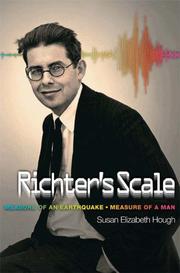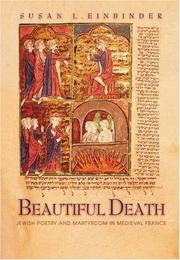| Listing 1 - 3 of 3 |
Sort by
|

ISBN: 1400884446 0691128073 9780691128078 9781400884445 0691173281 9780691173283 Year: 2016 Publisher: Princeton, NJ : Princeton University Press,
Abstract | Keywords | Export | Availability | Bookmark
 Loading...
Loading...Choose an application
- Reference Manager
- EndNote
- RefWorks (Direct export to RefWorks)
By developing the scale that bears his name, Charles Richter not only invented the concept of magnitude as a measure of earthquake size, he turned himself into nothing less than a household word. He remains the only seismologist whose name anyone outside of narrow scientific circles would likely recognize. Yet few understand the Richter scale itself, and even fewer have ever understood the man. Drawing on the wealth of papers Richter left behind, as well as dozens of interviews with his family and colleagues, Susan Hough takes the reader deep into Richter's complex life story, setting it in the context of his family and interpersonal attachments, his academic career, and the history of seismology. Among his colleagues Richter was known as intensely private, passionately interested in earthquakes, and iconoclastic. He was an avid nudist, seismologists tell each other with a grin; he dabbled in poetry. He was a publicity hound, some suggest, and more famous than he deserved to be. But even his closest associates were unaware that he struggled to reconcile an intense and abiding need for artistic expression with his scientific interests, or that his apparently strained relationship with his wife was more unconventional but also stronger than they knew. Moreover, they never realized that his well-known foibles might even have been the consequence of a profound neurological disorder. In this biography, Susan Hough artfully interweaves the stories of Richter's life with the history of earthquake exploration and seismology. In doing so, she illuminates the world of earth science for the lay reader, much as Sylvia Nasar brought the world of mathematics alive in A Beautiful Mind.
Richter scale. --- Seismologists --- Earthquakes. --- Richter, Charles, --- Quakes (Earthquakes) --- Scale, Richter --- Richter, Charles F. --- Richter, C. F. --- Richter, Charles Francis, --- Earth movements --- Natural disasters --- Seismology --- Earthquake magnitude --- Geophysicists --- Measurement --- 1811–12 New Madrid earthquakes. --- 1952 Kern County earthquake. --- Active fault. --- Allen Say. --- American Association of Variable Star Observers. --- Another Woman. --- Asperger syndrome. --- Autism. --- Barbara McClintock. --- Benioff. --- Beno Gutenberg. --- Book. --- Boris Podolsky. --- Calculation. --- Career. --- Charles Francis Richter. --- Child abuse. --- Clarence Allen (geologist). --- Classic book. --- Disaster. --- Distrust. --- Dr. Seuss. --- Dysfunctional family. --- Earthquake insurance. --- Earthquake prediction. --- Electra complex. --- Emerging technologies. --- Emotional baggage. --- Ernest Rutherford. --- Female hysteria. --- Field Act. --- Foreshock. --- Freaks. --- Geologist. --- Graduate school. --- Grandparent. --- Hanks. --- Harold Jeffreys. --- Headline. --- Hiking. --- Hiroo Kanamori. --- His Family. --- Hugo Benioff. --- Hypothyroidism. --- I Wish (manhwa). --- IBM Selectric typewriter. --- In Death. --- Inception. --- Incest. --- Indication (medicine). --- Industrial Workers of the World. --- Inge Lehmann. --- Joan Baez. --- Keiiti Aki. --- Lord Byron. --- Luke Jackson (author). --- Margaret Atwood. --- Mark Storey. --- Meanness. --- Modern physics. --- Mount Wilson Observatory. --- Mrs. --- National security. --- Neurosis. --- Nobel Prize in Physiology or Medicine. --- Nobel Prize. --- Nuclear family. --- Nuclear winter. --- Obsessive–compulsive disorder. --- Plate tectonics. --- Political correctness. --- Popular Science. --- Prediction. --- Procrastination. --- Quantum mechanics. --- Racism. --- Rain Man. --- Ramapo Fault. --- Richter magnitude scale. --- San Andreas Fault. --- Scientist. --- Seismological Society of America. --- Seismology. --- Seismometer. --- Southern California. --- Supervisor. --- Sylvia Nasar. --- Symptom. --- T. S. Eliot. --- Testimonial. --- The Parliament of Man. --- The Tumor. --- Thomas Wolfe. --- To This Day. --- Total loss. --- Treasure trove. --- Tsunami. --- V. --- Virginia Woolf. --- Writing.

ISBN: 1282157787 9786612157783 1400825253 9781400825257 9780691090535 069109053X 069109053X 9781282157781 Year: 2002 Publisher: Princeton, N.J. : Princeton University Press,
Abstract | Keywords | Export | Availability | Bookmark
 Loading...
Loading...Choose an application
- Reference Manager
- EndNote
- RefWorks (Direct export to RefWorks)
When Crusader armies on their way to the Holy Land attacked Jewish communities in the Rhine Valley, many Jews chose suicide over death at the hands of Christian mobs. With their defiant deaths, the medieval Jewish martyr was born. With the literary commemoration of the victims, Jewish martyrology followed. Beautiful Death examines the evolution of a long-neglected corpus of Hebrew poetry, the laments reflecting the specific conditions of Jewish life in northern France. The poems offer insight into everyday life and into the ways medieval French Jews responded to persecution. They also suggest that poetry was used to encourage resistance to intensifying pressures to convert. The educated Jewish elite in northern France was highly acculturated. Their poetry--particularly that emerging from the innovative Tosafist schools--reflects their engagement with the vernacular renaissance unfolding around them, as well as conscious and unconscious absorption of Christian popular beliefs and hagiographical conventions. At the same time, their extraordinary poems signal an increasingly harsh repudiation of Christianity's sacred symbols and beliefs. They reveal a complex relationship to Christian culture as Jews internalized elements of medieval culture even while expressing a powerful revulsion against the forms and beliefs of Christian life. This gracefully written study crosses traditional boundaries of history and literature and of Jewish and general medieval scholarship. Focusing on specific incidents of persecution and the literary commemorations they produced, it offers unique insights into the historical conditions in which these poems were written and performed.
Jews --- Judaism --- Martyrdom --- Martyrdom in literature. --- Hebrew literature, Medieval --- Hebrews --- Israelites --- Jewish people --- Jewry --- Judaic people --- Judaists --- Ethnology --- Religious adherents --- Semites --- Religions --- Martyrdom (Judaism) --- Persecutions --- History --- Judaism. --- History and criticism. --- Religion --- Abraham ibn Ezra. --- Allusion. --- Apostasy. --- Ashkenaz. --- Blood libel. --- Book burning. --- Book of Ezekiel. --- Books of Kings. --- Christian literature. --- Christianity. --- Conversion to Christianity. --- Conversion to Judaism. --- Crusades. --- Defection. --- Desecration. --- Desperation (novel). --- Elohim. --- Emeritus. --- Exegesis. --- Ezekiel. --- First Crusade. --- Gershom. --- God. --- Hagigah. --- Hagiography. --- Halevi. --- Harassment. --- Hazzan. --- Hebrew Bible. --- Hebrew language. --- Heresy. --- High Middle Ages. --- Historian. --- Host desecration. --- Humiliation. --- Illustration. --- In Death. --- Incorruptibility. --- Israelites. --- Jewish identity. --- Jewish studies. --- Jews. --- Kohen. --- Lament. --- Lamentations Rabbah. --- Laments (Kochanowski). --- Libation. --- Literature. --- Maimonides. --- Martyr. --- Martyrology. --- Medieval Hebrew. --- Meir of Rothenburg. --- Middle Ages. --- Mishnah. --- Nahmanides. --- Names of God in Judaism. --- Narrative. --- Old French. --- Penitential. --- Persecution. --- Piyyut. --- Poetry. --- Polemic. --- Princeton University. --- Prose. --- Psalms. --- Pyre. --- Quatrain. --- Rabbi. --- Rabbinic literature. --- Rashbam. --- Rashi. --- Relic. --- Religious text. --- Responsa. --- Righteousness. --- Second Crusade. --- Sefer (Hebrew). --- Sefer Hasidim. --- Simhah. --- Soloveitchik. --- Stanza. --- Suffering. --- Suggestion. --- Talmud. --- Tefillin. --- Ten Martyrs. --- The Other Hand. --- The Song of Roland. --- Torah scroll. --- Torah. --- Treatise. --- Troyes. --- V. --- Writer. --- Writing. --- Yechiel of Paris. --- Yom Tov of Joigny.
Book
ISBN: 1282531492 9786612531491 1400834325 9781400834327 0691145342 9780691145341 6612531495 9780691145341 9781282531499 Year: 2010 Publisher: Princeton, NJ : Princeton University Press,
Abstract | Keywords | Export | Availability | Bookmark
 Loading...
Loading...Choose an application
- Reference Manager
- EndNote
- RefWorks (Direct export to RefWorks)
In Last Looks, Last Books, the eminent critic Helen Vendler examines the ways in which five great modern American poets, writing their final books, try to find a style that does justice to life and death alike. With traditional religious consolations no longer available to them, these poets must invent new ways to express the crisis of death, as well as the paradoxical coexistence of a declining body and an undiminished consciousness. In The Rock, Wallace Stevens writes simultaneous narratives of winter and spring; in Ariel, Sylvia Plath sustains melodrama in cool formality; and in Day by Day, Robert Lowell subtracts from plenitude. In Geography III, Elizabeth Bishop is both caught and freed, while James Merrill, in A Scattering of Salts, creates a series of self-portraits as he dies, representing himself by such things as a Christmas tree, human tissue on a laboratory slide, and the evening/morning star. The solution for one poet will not serve for another; each must invent a bridge from an old style to a new one. Casting a last look at life as they contemplate death, these modern writers enrich the resources of lyric poetry.
Death in literature. --- American poetry --- History and criticism. --- Stevens, Wallace --- Criticism and interpretation --- Plath, Sylvia --- Lowell, Robert Traill Spence, Jr. --- Bishop, Elizabeth --- Merrill, James Ingram --- 20th century --- History and criticism --- Death in literature --- Adjective. --- After Apple-Picking. --- Allusion. --- Amputation. --- Ars Poetica (Horace). --- Asymmetry. --- Because I could not stop for Death. --- Bevel. --- Binocular vision. --- Bluebeard's Castle. --- Burial. --- Calcium carbonate. --- Carbon monoxide. --- Caspar David Friedrich. --- Coffin. --- Couplet. --- Death and Life. --- Death drive. --- Death. --- Deathbed. --- Desiccation. --- Diction. --- Disjecta membra. --- Dramatis Personae. --- Elizabeth Bishop. --- Emblem. --- Emily Dickinson. --- Emptiness. --- Executive director. --- Ezra Pound. --- Fairy tale. --- Fine art. --- Grandparent. --- Hexameter. --- Human extinction. --- Impermanence. --- In Death. --- In the Flesh (TV series). --- Incineration. --- Irony. --- James Merrill. --- John Donne. --- John Keats. --- Lady Lazarus. --- Lament. --- Last Poems. --- Lecture. --- Life Studies. --- Lycidas. --- Macabre. --- Melodrama. --- Metaphor. --- Microtome. --- Misery (novel). --- Mourning. --- Narcissism. --- Narrative. --- National Gallery of Art. --- National Humanities Center. --- Ottava rima. --- Otto Plath. --- Pentameter. --- Phone sex. --- Pity. --- Plath. --- Platitude. --- Poetry. --- Princeton University Press. --- Psychotherapy. --- Rhyme scheme. --- Rhyme. --- Rigor mortis. --- Robert Lowell. --- Sadness. --- Sestet. --- She Died. --- Skirt. --- Slowness (novel). --- Soliloquy. --- Sonnet. --- Stanza. --- Subtraction. --- Suffering. --- Suicide attempt. --- Sylvia Plath. --- Ted Hughes. --- Tercet. --- Terza rima. --- The Other Hand. --- The Snapper (novel). --- Trepanning. --- Tyvek. --- Villanelle. --- Vocation (poem). --- W. B. Yeats. --- W. H. Auden. --- Wallace Stevens. --- Wasting. --- William Shakespeare. --- Writing.
| Listing 1 - 3 of 3 |
Sort by
|

 Search
Search Feedback
Feedback About UniCat
About UniCat  Help
Help News
News